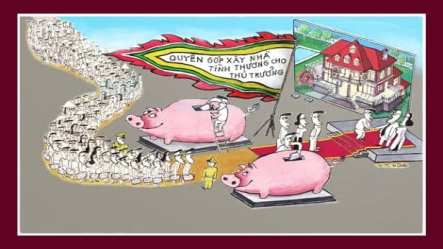Sức khỏe và đời sống
TUỔI THỌ ...của mỗi người ...đơn giản :
Thử nghiệm kiểu này chắc ai trên 6 chục cũng sắp sưả vô nhà quàn !!!!
Ông Araujo nói rằng phương pháp này thuyết
phục các bệnh nhân của ông, hơn là chỉ nghe ông khuyên bảo suông về việc
tập thể dục, và ăn uống lành mạnh.
(Google search : Claudio Gil Araujo).
Roen Kelly/Discover.
Người lớn tuổi có thể biết còn sống được bao lâu ?
Phương pháp của ông Araujo dựa vào sự dẻo
dai của bắp thịt, sự cân bằng, và sự mạnh mẽ cơ thể, khi đứng lên ngồi
xuống của những người lớn tuổi.
Từ nhận xét này ông Araujo cùng một số đồng
nghiệp có sáng kiến thiết lập ra một thử nghiệm đơn giản không cần máy
móc, mà mọi người trên 50 tuổi đều có thể tự mình, hay cùng với bạn bè
thực hành ở bất cứ nơi nào. Phương pháp này gọi là SRT (sitting-rise
test).
Bước đầu tiên
là đứng thẳng giữa phòng, từ từ ngồi trong tư thế tréo chân. Sau đó tự
đứng thẳng lên mà không dùng tay vịn, hoặc chống như trong hình. Thang
điểm để cho bài tập này là 10 điểm: 5 điểm cho động tác ngồi xuống và 5
điểm cho động tác đứng lên. Mỗi khi phải dùng đến đôi tay thì bị trừ một
điểm, và mỗi khi xiêu vẹo mất thăng bằng thì bị trừ nửa điểm. Bác sĩ
Araujo áp dụng bài tập trên đối với 2,000 người trong độ tuổi từ 51 đến
80, và kết quả cho thấy đa số những người có điểm dưới 8 chỉ sống thêm
khoảng 6 năm, người có điểm dưới 3 thì qua đời không lâu sau đó.
Nói chung: cứ mỗi điểm đạt được qua thử nghiệm ngồi và đứng lên, tượng trưng cho 21% cơ hội giảm thiểu tính tử vong.
Tuy phương pháp chính xác nhất đối với người ngoài 50, nhưng những người trẻ hơn cũng có thể thực hành.
Cũng theo ông Araujo, rất nhiều người sau
khi thử phương pháp SRT đã cố gắng thay đổi cách sinh hoạt qua việc ăn
uống, vận động, và tập luyện trong chừng mực của mình, để gia tăng sự dẻo
dai, và sức mạnh nhằm kéo dài tuổi thọ.
(Google search : Claudio Gil Araujo).
Simple Sitting Test Predicts How Long You'll Live
Flexibility, balance and muscle strength are key indicators of longevity.
By Becky Lang|Wednesday, December 11, 2013
RELATED TAGS:
PERSONAL HEALTH, AGING
Sit. Stand. Repeat. This little trick — a deceptively simple measure
of flexibility and strength — can predict who will live longer and whose
lives will be cut short, according to a study by Brazilian physician
Claudio Gil Araujo. He uses the test with athletes, but he also uses it
to lay out the stakes with patients: To live longer, they must get
moving and maintain muscle and balance.
Araujo noticed long ago that many of his patients, particularly older
people, had trouble with ordinary motions such as bending down to pick
up something off the floor — difficulty indicative of a loss of
flexibility. As people age, he knew, reduced muscle power and loss of
balance can greatly increase the risk of dangerous falls.
Araujo wanted to do more than just lecture his patients about the
importance of staying fit. He wanted to give them concrete information
about where they had room to improve. He believed that existing clinical
tests assessing flexibility, balance and muscle strength were too
impractical or time-consuming, requiring ample space for walking or
specific equipment such as a stopwatch or a particular type of
adjustable chair.
And because factors such as the height of the arms on a chair or a
clinician’s speed with a stopwatch can vary, the results could also be
unreliable. So he and colleagues developed an alternative, which they
call the sitting-rising test, or SRT. It requires no equipment or
walking paths — just a clear patch of floor and a willing participant.
In a study published in the European Journal of Cardiology,
Araujo had more than 2,000 patients ages 51 to 80, all part of an
exercise program at Clinimex Exercise Medicine Clinic in Rio de Janeiro,
take the SRT. People who scored fewer than eight points on the test, he
found, were twice as likely to die within the next six years compared
with those who scored higher; those who scored three or fewer points
were more than five times as likely to die within the same period
compared with those who scored more than eight points.
Overall, each point increase in the SRT score was associated with a
21 percent decrease in mortality from all causes. Araujo hopes such
information can help get more older people walking through the doors of a
gym rather than rolling into an emergency room.
Try It
1. Stand in comfortable clothes in your bare feet, with clear space around you.
2. Without leaning on anything, lower yourself to a sitting position on the floor.
3. Now stand back up, trying not to use your hands, knees, forearms or sides of your legs.
Roen Kelly/Discover
Scoring
The
two basic movements in the sitting-rising test — lowering to the floor
and standing back up — are each scored on a 1-to-5 scale, with one point
subtracted each time a hand or knee is used for support and 0.5 points
subtracted for loss of balance; this yields a single 10-point scale.
Bàn ra tán vào (0)
Các tin đã đăng
- "Phở Chua, Giấm Tiều" - by Mặc Lâm.
- "Cần phân biệt X-RAYS, CT SCAN, MRI, PET SCAN và ULTRASOUND" - By Bác Sĩ Hồ Ngọc Minh.- Trần Văn Giang ghi lại
- "Kinh Nghiệm của Người Bị Đau Tim" - by Nguyễn Hưng. Trần Văn Giang ghi lại
- Ôi “Thần Dược!” - Huỳnh Chiếu Đẳng ( Trần Văn Giang ghi lại )
- Cá Trắm nấu canh chua
TUỔI THỌ ...của mỗi người ...đơn giản :
Thử nghiệm kiểu này chắc ai trên 6 chục cũng sắp sưả vô nhà quàn !!!!
Người lớn tuổi có thể biết còn sống được bao lâu ?
Phương pháp của ông Araujo dựa vào sự dẻo
dai của bắp thịt, sự cân bằng, và sự mạnh mẽ cơ thể, khi đứng lên ngồi
xuống của những người lớn tuổi.
Từ nhận xét này ông Araujo cùng một số đồng
nghiệp có sáng kiến thiết lập ra một thử nghiệm đơn giản không cần máy
móc, mà mọi người trên 50 tuổi đều có thể tự mình, hay cùng với bạn bè
thực hành ở bất cứ nơi nào. Phương pháp này gọi là SRT (sitting-rise
test).
Bước đầu tiên
là đứng thẳng giữa phòng, từ từ ngồi trong tư thế tréo chân. Sau đó tự
đứng thẳng lên mà không dùng tay vịn, hoặc chống như trong hình. Thang
điểm để cho bài tập này là 10 điểm: 5 điểm cho động tác ngồi xuống và 5
điểm cho động tác đứng lên. Mỗi khi phải dùng đến đôi tay thì bị trừ một
điểm, và mỗi khi xiêu vẹo mất thăng bằng thì bị trừ nửa điểm. Bác sĩ
Araujo áp dụng bài tập trên đối với 2,000 người trong độ tuổi từ 51 đến
80, và kết quả cho thấy đa số những người có điểm dưới 8 chỉ sống thêm
khoảng 6 năm, người có điểm dưới 3 thì qua đời không lâu sau đó.
Nói chung: cứ mỗi điểm đạt được qua thử nghiệm ngồi và đứng lên, tượng trưng cho 21% cơ hội giảm thiểu tính tử vong.
Tuy phương pháp chính xác nhất đối với người ngoài 50, nhưng những người trẻ hơn cũng có thể thực hành.
Cũng theo ông Araujo, rất nhiều người sau
khi thử phương pháp SRT đã cố gắng thay đổi cách sinh hoạt qua việc ăn
uống, vận động, và tập luyện trong chừng mực của mình, để gia tăng sự dẻo
dai, và sức mạnh nhằm kéo dài tuổi thọ.
(Google search : Claudio Gil Araujo).
Simple Sitting Test Predicts How Long You'll Live
Flexibility, balance and muscle strength are key indicators of longevity.
By Becky Lang|Wednesday, December 11, 2013
RELATED TAGS:
PERSONAL HEALTH, AGING
Sit. Stand. Repeat. This little trick — a deceptively simple measure
of flexibility and strength — can predict who will live longer and whose
lives will be cut short, according to a study by Brazilian physician
Claudio Gil Araujo. He uses the test with athletes, but he also uses it
to lay out the stakes with patients: To live longer, they must get
moving and maintain muscle and balance.
Araujo noticed long ago that many of his patients, particularly older
people, had trouble with ordinary motions such as bending down to pick
up something off the floor — difficulty indicative of a loss of
flexibility. As people age, he knew, reduced muscle power and loss of
balance can greatly increase the risk of dangerous falls.
Araujo wanted to do more than just lecture his patients about the
importance of staying fit. He wanted to give them concrete information
about where they had room to improve. He believed that existing clinical
tests assessing flexibility, balance and muscle strength were too
impractical or time-consuming, requiring ample space for walking or
specific equipment such as a stopwatch or a particular type of
adjustable chair.
And because factors such as the height of the arms on a chair or a
clinician’s speed with a stopwatch can vary, the results could also be
unreliable. So he and colleagues developed an alternative, which they
call the sitting-rising test, or SRT. It requires no equipment or
walking paths — just a clear patch of floor and a willing participant.
In a study published in the European Journal of Cardiology,
Araujo had more than 2,000 patients ages 51 to 80, all part of an
exercise program at Clinimex Exercise Medicine Clinic in Rio de Janeiro,
take the SRT. People who scored fewer than eight points on the test, he
found, were twice as likely to die within the next six years compared
with those who scored higher; those who scored three or fewer points
were more than five times as likely to die within the same period
compared with those who scored more than eight points.
Overall, each point increase in the SRT score was associated with a
21 percent decrease in mortality from all causes. Araujo hopes such
information can help get more older people walking through the doors of a
gym rather than rolling into an emergency room.
Try It
1. Stand in comfortable clothes in your bare feet, with clear space around you.
2. Without leaning on anything, lower yourself to a sitting position on the floor.
3. Now stand back up, trying not to use your hands, knees, forearms or sides of your legs.
Roen Kelly/Discover
Scoring
The
two basic movements in the sitting-rising test — lowering to the floor
and standing back up — are each scored on a 1-to-5 scale, with one point
subtracted each time a hand or knee is used for support and 0.5 points
subtracted for loss of balance; this yields a single 10-point scale.























